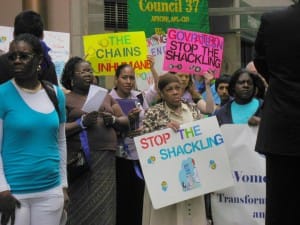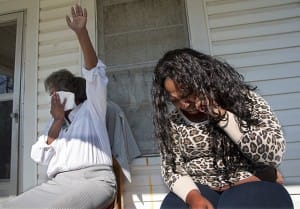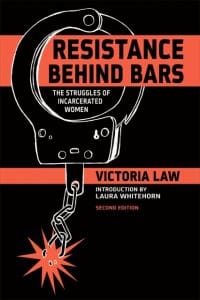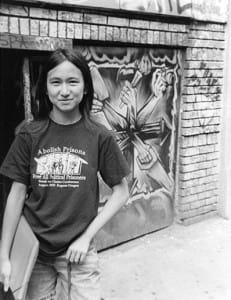by Maya Schenwar, Truthout

When we think of protest behind bars, what comes to mind? For many people, that list would include the Attica uprising, the work of George Jackson, the struggles of the Angola 3 activists, the 2013 California prison hunger strike and other crucial instances of resistance – mostly organized by incarcerated men.
Too often, organizing work done by incarcerated women goes wholly unrecognized. In her book, “Resistance Behind Bars: The Struggles of Incarcerated Women,” Victoria Law focuses on the many forms of activism happening inside of women’s prisons, most of which never reach the dominant media.
In the following interview, Law shares stories of little-known actions, insights into what constitutes “activism” and ways in which individual acts of resistance are building toward a transformational new reality.
Maya Schenwar: You discuss in the book how, when you first got interested in resistance within prisons and noticed a dearth of information about women’s organizing, you were often told, “Women don’t organize.” I’ve definitely noticed that the actions that we hear most about – particularly in mass media, but even among outside activist communities – are focused on men. What are some of the factors that create and perpetuate this myth that women behind bars aren’t “politicized” or engaged in resistance?
Victoria Law: We don’t hear very much about what’s happening in women’s prisons. If we hear about what’s going on inside, it’s usually framed as “these are the conditions,” not “these are the conditions, and this is what people inside these jails and prisons are doing about it.”
Even in 2015, prisoner resistance is still largely thought of as male. Part of it is that more attention is paid to men’s jails and prisons – they do, after all, make up approximately 90 percent of those behind bars. Part of it is that support networks for men are different than for women – including trans women – behind bars.
For example, during the Pelican Bay hunger strike, we saw women family members stepping to the forefront to speak about the conditions their loved ones have been enduring. Although we know, barely, that people in California’s women’s prisons had also been fasting in solidarity – and we know that there is also a SHU (Security Housing Unit) at the women’s prison – we’re not seeing – or hearing – outside loved ones amplifying their voices and efforts to the same extent that women like Dolores Canales, Marie Levin and Daletha Hayden are doing for their male loved ones.
We don’t hear very much about what’s happening in women’s prisons. If we hear about what’s going on inside, it’s usually framed as “these are the conditions,” not “these are the conditions, and this is what people inside these jails and prisons are doing about it.”
In addition, even in this day and age, prison issues are frequently framed as men’s issues – unless it’s an issue like pregnancy, reproductive health or sexual abuse. So when we talk about solitary confinement, even though solitary confinement is used throughout women’s prisons and jails, coverage is often about what happens to men. The people spotlighted are men.

Sometimes, women will speak, like Evie Litwok and Donna Hylton about their experiences in solitary at a NYC hearing. But, unless it’s specifically a story about women in solitary or trans people in solitary, we don’t often see recognition that these conditions affect people of all genders. It’s not just solitary confinement where male becomes the default gender.
Finally, some of the ways women are challenging and resisting aren’t seen as fitting what we might think of as “resistance” or “organizing.” For example, currently and formerly incarcerated women have been involved in challenging policies around parenting – or maintaining their right to parent. It’s an issue that disproportionately affects incarcerated mothers because, when a father goes to prison, he often has a female relative willing to take care of his children.
When a mother goes to prison, she is less likely to have that same network of support and faces a greater chance that her children will end up in foster care. Children of incarcerated mothers are five times more likely to end up in foster care than children of incarcerated fathers, which makes fighting to maintain custody an issue that many incarcerated women face.
Some women have individually helped challenge these policies – I wrote about Mary Glover, the legendary jailhouse lawyer in Michigan’s women’s prison, who helped women with their custody cases during the 20 or so years she was behind bars. She also filed Glover v. Johnson, which required the prison to have equal educational and vocational programing for men’s and women’s prisons, a landmark 1970s case.
More recently, Arlinda Johns did the same for moms in the federal system. Moms have also organized to change policies around termination of rights – collecting and compiling testimony on the effects of permanent separation from their children, sharing their stories etc.
Some of the ways women are challenging and resisting aren’t seen as fitting what we might think of as “resistance” or “organizing.”
Maya Schenwar: Not all of the forms of resistance you discuss correspond to a normative idea of what “protest” means. For example, you chronicle the prisoner-led establishment of unique literacy programs at a prison in New York – a process that involved collaborating with prison officials (working “with the system”). You even discuss “listening” – in the service of community-building – as a type of action behind bars. Can you discuss why it is important to recognize this wide variety of activities as political acts?
Victoria Law: Prisons isolate people. They’re not meant to strengthen bonds between people or build community. People inside prisons can be punished for simple, humane acts like hugging or sharing. Prison rules and staff discourage people from helping each other out.
One example: A woman in an education program recently told me that one of her classmates has arthritis and thus cannot type the paper assigned to the class. Prison rules prohibit anyone else from typing her paper for her. “Do I type the paper for her so that she can pass the class or do I go by the rules?” the woman wondered.

While typing a paper doesn’t overturn this particular rule, the act of doing so not only helps the woman with arthritis, but also demonstrates caring and compassion in an environment designed to break it out of people. I’ve heard from women who have lost family members or custody of their children. … A listening ear makes all the difference in how they are able to process their grief.
Sometimes these acts of listening turn into something more widespread – for example, through the act of creating an environment in which women could share their experiences, the support group for women serving long sentences in Ohio realized that abuse and domestic violence were a pathway to long or life sentences and launched the first successful mass clemency campaign for battered women. But this wouldn’t have happened without that first step of listening.
Maya Schenwar: I think it’s so important that your book contains a chapter about grievances and lawsuits and the importance of the media in amplifying those efforts. How do these legal tools, which often stem from individual harms, contribute to larger goals of resistance? And how can we as the media serve to amplify them in a way that supports the work?
Victoria Law: We need to remember that, while a grievance might reflect one person’s experience of individual harm, that experience is frequently reflective of a larger, more systemic reality affecting everyone in that jail or prison. A woman filing a grievance against a particularly abusive officer, for example, is probably not the only person who has experienced abuse from that person. One woman’s complaint about inadequate or negligent health care probably reflects many other women’s experiences.
While a grievance might reflect one person’s experience of individual harm, that experience is frequently reflective of a larger, more systemic reality affecting everyone in that jail or prison.
These grievances are important because, under the 1995 Prison Litigation Reform Act, people in prison are required to exhaust every administrative remedy before filing a lawsuit in civil court. In other words, if the person hasn’t been filing grievances and appeals, the court won’t hear their case.
Individual – or even collective filings of – grievances don’t make the news. Lawsuits occasionally do. Covering lawsuits allows journalists to highlight some of the conditions that people in prison are litigating to change, conditions that may not be considered newsworthy otherwise because they happen all the time.
One of the ways in which media can serve to amplify these efforts is to talk with people most affected – the people inside and their family members and friends on the outside. Those are the people doing the on-the-ground work and who know exactly what’s happening.
Of course, trying to communicate with people inside takes time, patience and sometimes money (especially if you’re relying on collect calls, for-profit email servers and snail mail). These may seem to be luxuries for people who are on a deadline or operating on a small budget, but they are crucial to understanding the crux of the problem from the people who are forced to live it every day.

Maya Schenwar: I love the section of your book that talks about how women behind bars do their own media work, finding creative ways to raise consciousness. Can you discuss some of the ways that women in prison get the word out about what’s happening behind bars?
Victoria Law: As I said earlier, the networks that women are able to tap into are often different than those that men utilize. But women in prison use the networks and resources available to them to get the word out. Some of them use whatever email service the prison has to let people know about conditions. Their supporters then post their emails online, whether on dedicated sites, blogs or Facebook pages.
In the past, these networks have often included feminist publications. During the 1970s, off our backs regularly published writings by women in prison or updates by outside supporters about what was going on inside women’s prisons. Several other feminist publications also had regular imprisoned contributors. They also sent copies of their publication to women inside so that they felt connected to the outside world – and the various political struggles.
In the online age, that kind of inside-outside connection is a little harder to maintain, but several groups continue to produce print newsletters that can be mailed into prisons: For instance, Black & Pink has a newspaper that they send to over 7,500 LGBTQ people imprisoned across the country, while the California Coalition for Women Prisoners has, since the 1990s, produced The Fire Inside and sent it to its members imprisoned in California.
They also write letters to anyone and everyone whose snail mail addresses they can get their hands on, letting them know what’s going on inside.
The networks that women are able to tap into are often different than those that men utilize. But women in prison use the networks and resources available to them to get the word out.
Maya Schenwar: Sexual abuse by correctional officers is rampant in women’s prisons, and you discuss some of the ways in which incarcerated women are confronting the issue. This is a particularly difficult battle to wage, given the real threat of retaliation for women who speak out about sexual violence. What are some of the strategies that women use to protect themselves and each other and to challenge the larger problem of sexual violence that is ingrained in the system?
Victoria Law: Keep in mind that in jails and prisons, movements are very restricted. So strategies that might work on the outside – like staying in groups or avoiding deserted areas – don’t work in prison. Staff not only hold the keys to people’s cells, but also have the ability to give orders to those in custody. If they refuse, they risk being charged with “disobeying a direct order,” which can lead to time in solitary confinement and/or be used against them during a parole hearing.
Despite this, women have figured out ways to try to protect themselves and others. One woman, incarcerated in the mid-1990s, recalled a guard who constantly harassed her cellmate. He threatened her and her friends that, if they tried to report him, he would place cocaine among their possessions. His threat worked – the women kept quiet about his harassment.

Women have also filed lawsuits to try to change policies that allow such abuse to happen. In Michigan, one of the dozen lawsuits Mary Glover filed led to a change in policy banning men from pat-searching women, being in the housing units and limiting other areas they could be in, such as medical examining rooms.
Maya Schenwar: The newest edition of your book has a chapter that’s specifically focused on trans, intersex and gender nonconforming people in prison. What are some specific struggles that trans, intersex and gender nonconforming people face in prison – and some sites of resistance?
Victoria Law: Keep in mind that trans people behind bars face all of the same struggles as their cisgender (or people who identify with the sex assigned to them at birth) counterparts. But, being trans also means that they face a whole host of other problems, too.
Let’s start with placement. Contrary to what the Netflix series “Orange is the New Black” may have you believe, most trans women are not placed in women’s prisons. Sentencing usually goes by the sex on a birth certificate, meaning that trans women are often sent to men’s jails and prisons. There, they face the very real threat of sexual harassment and assault by both staff and the men with whom they are incarcerated. They also face physical – and often brutal – violence.
People who are on hormones before entering prison often have to fight to maintain access to hormone treatment. Some prison systems only allow hormone treatment if the person had a legal prescription before their arrest.
But, like their cisgender counterparts, many who end up in prison are low-income or underemployed and may not have had health insurance or access to legally prescribed hormone therapy. Without that prescription, they can be denied treatment altogether.
But even having a prescription is no guarantee that the prison will honor it. As I reported in one of my earliest stories for Truthout, CeCe McDonald entered prison with both a legal prescription and a court order for 20 milligrams of hormones. Despite that, prison staff only gave her 6 milligrams until supporters from around the world flooded the prison with calls, demanding that she receive her full treatment.
Keep in mind that trans people behind bars face all of the same struggles as their cisgender counterparts. But, being trans also means that they face a whole host of other problems, too.
Ashley Diamond had to file a lawsuit against the Georgia Department of Corrections to get access to hormone therapy. Her lawsuit led to a New York Times profile and several articles about her struggles against medical, physical and sexual violence in a men’s prison, which led to the Department of Justice getting involved on her behalf. In response, the Georgia Department of Corrections changed its policy around hormone therapy and began issuing her a small amount of hormones.
These are the stories that we know and that have been publicized. There are many more names and experiences that we don’t know – I recently received a letter from a trans woman in California who said that she had been sexually assaulted by a guard. She was only believed after she showed prison officials his semen and took a polygraph test. The guard was allowed to retire with full benefits. She remains in prison.
Maya Schenwar: You discuss how activism extends beyond the bars – how the work that women have done while they’re incarcerated “doesn’t stop at the prison gate.” Can you talk about some of the resistance work currently being done by formerly incarcerated women?

Victoria Law: Yes! Since Season 3 of “Orange is the New Black” is now out, readers should know about the work of Families for Justice as Healing, an organization that was started at the real-life prison where OITNB takes place. The organization has worked to raise awareness about the impact of the War on Drugs on women.
Last year, it held the FreeHer! rally in Washington, D.C., bringing together people working against incarceration as well as formerly incarcerated women, like Dorothy Gaines and Susan Rosenberg, both of whom were issued clemency by Clinton before he left office. Families has also worked to free women incarcerated as part of the drug war: Earlier this year, they celebrated the release of “Grandma” Hardy after nearly 23.5 years in prison.
Now, they’re pushing for a bill that would push Massachusetts judges to consider whether a person is a primary caregiver and, if so, to sentence them to a community-based alternative rather than to prison. This summer, they’re also organizing a summer camp for daughters of incarcerated women in which the girls will have the opportunity to learn both computer coding and criminal justice organizing. And, because incarceration not only isolates people inside prisons, but family members on the outside from their communities, it gives the girls the opportunity to connect and build with each other.
Andrea James, the director and one of the cofounders of Families for Justice as Healing, was recently awarded a Soros Justice fellowship to organize a national network of formerly incarcerated women. I’m hoping that the award indicates a lifting of the invisibility surrounding incarcerated women’s organizing and resistance.
Maya Schenwar is Truthout’s editor-in-chief and the author of “Locked Down, Locked Out: Why Prison Doesn’t Work and How We Can Do Better.” Follow her on Twitter @mayaschenwar. Previously, she was a senior editor and reporter at Truthout, writing on U.S. defense policy, the criminal justice system, campaign politics and immigration reform. Prior to her work at Truthout, Maya was contributing editor at Punk Planet magazine. She has also written for theGuardian, In These Times, Ms. Magazine, AlterNet, Z Magazine, Bitch Magazine, Common Dreams, the New Jersey Star-Ledger and others. She also served as a publicity coordinator for Voices for Creative Nonviolence. Maya is on the Board of Advisors at Waging Nonviolence.
In “Resistance Behind Bars,” regular Truthout contributor Victoria Law provides much-needed documentation of collective organizing and the daily struggles inside women’s prisons. This second edition includes powerful new sections examining the challenges facing trans, intersex and gender-variant people in prison as well as their acts of resistance. Order this award-winning book today by making a contribution to Truthout!
Copyright, Truthout. May not be reprinted without permission. This story was originally published June 28, 2015, by Truthout and is republished with permission.
Charisse Shumate: Fighting for Our Lives from Freedom Archives on Vimeo.
This 37-minute video was created in collaboration with the California Coalition for Women Prisoners and focuses on the life of legendary prisoner advocate Charisse Shumate and other women in California state prisons. It includes amazing prison interviews as well as materials from state Senate hearings on conditions for women in the California State Prison System and historical video footage of Charisse and her family.





